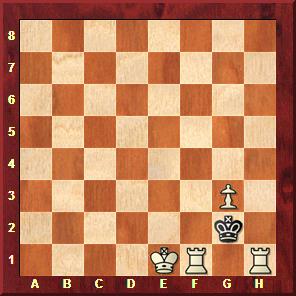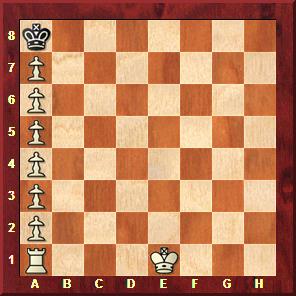ChessBase Chrismas Puzzles 2014 – solutions

December 25, 2014: ChessBase Christmas Puzzle 2000
|
A game ends with the move
6.gxf8=N mate. How did it go?
|
No solution given – but you can consult the feedback we received in fourteen years ago for hints
December 26, 2014: from ChessBase Christmas Puzzles 2001
Here is a very famous game, or rather a small extract of it. The replay board only shows the moves of the black knight in the course of the game, as does the diagram on the right. This knight was absolutely decisive. It tore into the white position, creating mayhem and winning the encounter for Black. Your task is to identify the game and the players. It is one of the best-known games in chess history.

Solution: The knight moves occurred in a very famous game, often referred to as the "Game of the Century", that was played by the 13-year-old Bobby Fischer at the Rosenwald Tournament, New York 1956.You can read an extensive tribute to the game here.

[Event "New York, Rosenwald Tournament"] [Site "?"] [Date "1956.??.??"] [Round "?"] [White "Byrne, D."] [Black "Fischer, R."] [Result "0-1"] [ECO "D97"] [Annotator "Frederic Friedel"] [PlyCount "82"] [EventDate "1956.??.??"] {This is the very famous game, often referred to as the "game of the century". It was played by the 13-year-old Bobby Fischer at the Rosenwald Tournament, New York 1956.} 1. Nf3 Nf6 {Keep your eye on this black knight, which is going to do all the damage!} 2. c4 g6 3. Nc3 Bg7 4. d4 O-O 5. Bf4 d5 6. Qb3 dxc4 7. Qxc4 c6 8. e4 Nbd7 9. Rd1 Nb6 10. Qc5 Bg4 11. Bg5 Na4 12. Qa3 Nxc3 13. bxc3 Nxe4 14. Bxe7 Qb6 15. Bc4 Nxc3 16. Bc5 Rfe8+ 17. Kf1 Be6 18. Bxb6 Bxc4+ 19. Kg1 Ne2+ 20. Kf1 Nxd4+ 21. Kg1 Ne2+ 22. Kf1 Nc3+ 23. Kg1 axb6 24. Qb4 Ra4 25. Qxb6 Nxd1 26. h3 Rxa2 27. Kh2 Nxf2 28. Re1 Rxe1 29. Qd8+ Bf8 30. Nxe1 Bd5 31. Nf3 Ne4 32. Qb8 b5 33. h4 h5 34. Ne5 Kg7 35. Kg1 Bc5+ 36. Kf1 Ng3+ 37. Ke1 Bb4+ 38. Kd1 Bb3+ 39. Kc1 Ne2+ 40. Kb1 Nc3+ 41. Kc1 Rc2# 0-1
The deadly knight
Chess studies are often profound, subtle or instructive. But some are just plain fun. Here's an example in which you can do what you probably often dreamed of in your regular club games. Go for it, have a ball!
J. Mendheim, Berlin 1932

White to play and win

[Event "Berlin"] [Site "?"] [Date "1932.??.??"] [Round "?"] [White "Mendheim, Julius"] [Black "White to play and win"] [Result "1-0"] [SetUp "1"] [FEN "3r1bk1/1p4pn/p1pp1p1p/R3p1r1/K1N4n/8/BP3q2/7R w - - 0 1"] [PlyCount "23"] [EventDate "1932.??.??"] 1. Nxd6+ Kh8 2. Nf7+ Kg8 3. Nxd8+ Kh8 4. Nf7+ Kg8 5. Nxh6+ Kh8 6. Nf7+ Kg8 7. Nxg5+ Kh8 8. Nf7+ Kg8 9. Nxe5+ Kh8 10. Ng6+ Nxg6 11. Rxh7+ Kxh7 12. Rh5# {Now wasn't that fun?} 1-0
December 27, 2014: from ChessBase Christmas Puzzles 2001
The depth of Kasparian's ideas and the artistry of execution has never been surpassed. Of the 400 studies that we have by this great composer around 300 received prizes and awards. He was a Grandmaster for Study Composition and six-time Champion for study composition in the USSR. Here is my all-time favourite Kasparian study:
Genrikh Kasparian, Shakhmaty v SSSR 1935

White to play and win

[Event "Chess in USSR"] [Site "?"] [Date "1935.??.??"] [Round "?"] [White "Kasparjan, G."] [Black "White to play and win"] [Result "1-0"] [SetUp "1"] [FEN "2B3K1/8/3N1p1p/6pk/5P1P/6P1/7r/5r2 w - - 0 1"] [PlyCount "11"] [EventDate "1935.??.??"] 1. Ne8 (1. Nf5 $2 {does not work:} Kg4 2. Ne3+ Kf3 3. Nxf1 Rf2 {and the game is drawn.}) 1... Kg6 2. h5+ Rxh5 3. f5+ Rxf5 4. g4 Re5 5. Bf5+ $1 (5. Ng7 f5 { is a draw.}) 5... Rxf5 6. Ng7 {[#]Cross your heart, have you ever seen a position as beautiful as this. And it was forced from the initial position of study. White will mate with the pawn on the next move.} 1-0
Samuel Loyd, New York Albion 1857

White to play and mate in three moves
Sam Loyd's biographer, A. C. White, calls the following "one of the world's most famous problems". Loyd, who published the problem before he had turned 16, referred to it as "a neat little position". You need a tiny bit of lateral thinking in order to solve it. Solution: 1.Rf4 Kxg3 (or 1...Kxh1 2.Kf2 Kh2 3.Rh4#) 2.0-0, This is the move that people tend to overlook – the cleverly hidden option of castling! 2...Kh3 3.R1f3# 1-0.
The Shinkman problem is a beautiful, almost architectual position. Another great composer, Werner Speckmann, mused that "one might think the the rules of the present-day game of chess had been especially invented to produce this problem". Unfortunately a second solution (or "cook") was later found. But for once this does not seem to have destroyed immortality of the problem. When you find the solution that the author originally intended you will immediately recognise its beauty. The cook is ugly and convoluted.
W. A. Shinkman, St. Louis Globe Democrat 1887

White to play and mate in eight
Incidentally Shinkman originally intended the position as a retro-analytical exercise, not a classical mate problem. The question was how can one achieve the above position in a normal game of chess, only executing legal moves. It can be reached in 34 moves from the initial position. Naturally both sides must cooperate to achieve the goal. This task is only for experienced problem experts.

[Event "?"] [Site "?"] [Date "2001.09.26"] [Round "?"] [White "Shinkman/al-Hajiri"] [Black "Proof game"] [Result "*"] [ECO "A00"] [PlyCount "83"] [EventDate "2001.??.??"] {Proof game by Bader Al-Hajiri from Kuwait.} 1. g4 e5 2. Nh3 Ba3 3. bxa3 h5 4. Bb2 hxg4 5. Bc3 Rh4 6. Bd4 exd4 7. Nc3 dxc3 8. dxc3 g3 9. Qd3 Rb4 10. Nf4 g5 11. h4 f5 12. h5 d5 13. h6 Bd7 14. h7 g2 15. h8=B g1=R 16. Bd4 Ba4 17. Rh4 Rg3 18. Bg2 gxf4 19. Be3 fxe3 20. Be4 fxe4 21. fxe3 exd3 22. exd3 c5 23. Rc4 dxc4 24. dxc4 b5 25. cxb4 Qa5 26. cxb5 Na6 27. bxa5 O-O-O 28. bxa6 Rd4 29. exd4 Rb3 30. cxb3 Ne7 31. bxa4 Nd5 32. dxc5 Nb6 33. cxb6 Kb8 34. bxa7+ Ka8 {[#] Shinkman's problem; White to play and mate in 8 moves (two solutions).} 35. O-O-O (35. Kd2 Kxa7 36. Re1 Kxa6 (36... Kb8 37. Re8+ Ka7 (37... Kc7 38. a7 Kc6 39. a8=Q+ Kd6 40. Qd8+ Kc6 41. Re7 Kc5 42. Rc7#) 38. Kc3 Kxa6 39. Re7 Kxa5 40. Re6 Kxa4 41. Re5 Kxa3 42. Ra5#) 37. Re7 Kxa5 38. Re6 Kxa4 39. Re5 Kxa3 40. Kc3 Kxa2 (40... Ka4 41. Rh5 Ka3 42. Ra5#) 41. Re1 Ka3 42. Ra1#) 35... Kxa7 36. Rd8 Kxa6 37. Rd7 Kxa5 38. Rd6 Kxa4 39. Rd5 Kxa3 40. Rd4 Kxa2 41. Rd3 Ka1 42. Ra3# *
December 28, 2014: from ChessBase Christmas Puzzles 2001
Raymond Smullyan, Manchester Guardian 1957

In the above position White has just removed his king from the board.
From which square, and what were the last two moves?

Solution: above is the position with which everything started. Now the moves 1.c4 bxc3+ 2.Kxc3+ leads to the position in the puzzle diagram, with the white king inserted on the correct square: c3.
– The solutions to the December 29–31 studies and puzzles will be given shortly –









































